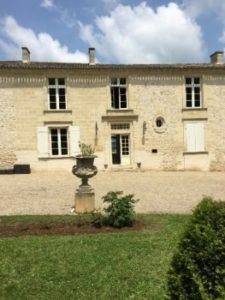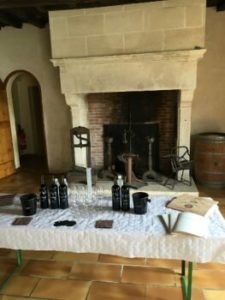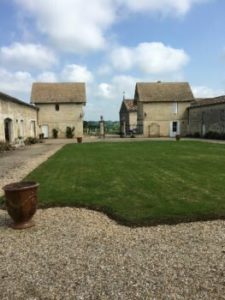Paul Smith, our Financial Director, has again had the chance to visit Bordeaux to discover new wines, chateaux and meet its winemakers. This is the second in this series of blogs about his trip and his discoveries . . .
 We focused on Crus & Domaines Right Bank chateaux, featuring Merlot in all its glory, and tasted wines from Saint Emilion, Montagne Saint Emilion, Pomerol, Lalande de Pomerol and – interestingly – Cadillac.
We focused on Crus & Domaines Right Bank chateaux, featuring Merlot in all its glory, and tasted wines from Saint Emilion, Montagne Saint Emilion, Pomerol, Lalande de Pomerol and – interestingly – Cadillac.
You’ll find my notes and tips on each wine tasted in my next blog post.My visit to Chateau Cantin in Saint Emilion provided one of the big highlights of my trip to Bordeaux.
Cantin belongs to Crus & Domaines de France – a Negotiant House and owners of several chateaux. This visit was themed around Merlot and turned out to be quite a revelation.
Whilst at Chateau Cantin we were given five bottles of Merlot 2015 produced from different parcels (plots) of vines on the Cantin estate. We were challenged to rank them in order of our preference and then to make our own blend of the 2015 vintage. This was a sensational experience as I could not believe how different the five Merlots were. Each Merlot had its own unique characteristics within the tannins, fruit, nose, balance and structure.

 The art of blending Bordeaux has been a real eye opener for me. It’s a craft that has been practiced for centuries and is the secret of Bordeaux’s success (you can learn more about blending Bordeaux on our blogs Bordeaux’s Secret Recipes – The Red Blends and The White Blends). Blending is such an intricate skill as it goes far beyond mixing different wines together. It all starts in the vineyard . . .
The art of blending Bordeaux has been a real eye opener for me. It’s a craft that has been practiced for centuries and is the secret of Bordeaux’s success (you can learn more about blending Bordeaux on our blogs Bordeaux’s Secret Recipes – The Red Blends and The White Blends). Blending is such an intricate skill as it goes far beyond mixing different wines together. It all starts in the vineyard . . .
 Each part is defined by its terroir. Terroir is a French term for a set of environmental conditions (soil type, topography and climate) that give a wine its particular aroma and flavour.The vineyard of a chateau is a complex living entity with many different parts.
Each part is defined by its terroir. Terroir is a French term for a set of environmental conditions (soil type, topography and climate) that give a wine its particular aroma and flavour.The vineyard of a chateau is a complex living entity with many different parts.
The terrain that it stretches over can have all sorts of contours and undulations; it can be criss crossed by little streams, sit facing a great river or stand prominent inland on a hilly slope.
It can lie on top of a multitude of soils and bed rocks, face different points of the compass and have its very own micro climates. Each part of this patchwork within the landscape will have a unique character that will affect the type of grape grown and the wine produced.
 You might think that this is an awful lot of fuss just to produce wine. But this is where the five Merlots prove a point.
You might think that this is an awful lot of fuss just to produce wine. But this is where the five Merlots prove a point.
Each bottle came from a different parcel of Merlot vines on the estate. It was extraordinary how different each wine was considering that they were all made with the same grape!Bordelaise wine makers take terroir very seriously.
They go to extraordinary lengths to analyse the chemical composition and mineral content of the soil (grapevines like well drained soils); examine the gradient of each part of the vineyard and assess its exposure (to wind and sun) and then allocate a parcel of grapevines best suited to its individual conditions. Each parcel has its own vat to keep the wine produced from the grapes separate. It’s precision agriculture at its finest.
 If you’d like to learn more about the wines I tasted at Chateau Cantin – and tips why they are good value for money – check out my blog post: Discovering New Wines in Bordeaux – Insights from the Inside – Part 3. Notes & Tips on the Merlot Blends.Of course the process of blending doesn’t stop there. The winemaker will use these five different batches of Merlot to perfect the final blend of Cantin’s 2015 vintage.
If you’d like to learn more about the wines I tasted at Chateau Cantin – and tips why they are good value for money – check out my blog post: Discovering New Wines in Bordeaux – Insights from the Inside – Part 3. Notes & Tips on the Merlot Blends.Of course the process of blending doesn’t stop there. The winemaker will use these five different batches of Merlot to perfect the final blend of Cantin’s 2015 vintage.
Once the wine maker is satisfied with his blend of Merlot this in turn is added to their blends of Cabernet Sauvignon and Cabernet Franc (and any other blends of Bordelaise grapes they might be growing such as Petit Verdot, Malbec or Carmenere).
The aim is to produce a perfect wine that reflects the style of the chateau and its region. It’s an intricate and painstaking process that has left me with huge respect for the wine makers.

